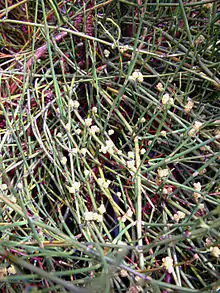| Chinese ephedra (Cao Ma Huang—草麻黄) | |
|---|---|
 | |
| Ephedra sinica | |
| Scientific classification | |
| Kingdom: | Plantae |
| Clade: | Tracheophytes |
| Clade: | Gymnospermae |
| Division: | Gnetophyta |
| Class: | Gnetopsida |
| Order: | Ephedrales |
| Family: | Ephedraceae |
| Genus: | Ephedra |
| Species: | E. sinica |
| Binomial name | |
| Ephedra sinica Stapf | |
| Synonyms[2] | |
| |
Ephedra sinica (also known as Chinese ephedra or Ma Huang) is a species of Ephedra native to Mongolia, Russia (Buryatiya, Chita, Primorye), and northeastern China (Gansu, Hebei, Heilongjiang, Jilin, Liaoning, Nei Mongol, Ningxia, Shaanxi, Shanxi).[2][3]
Uses
Medicinal
It is the primary source of the medicinal preparation ephedra, also known by its Chinese name ma huang. It has been proposed as a candidate for the legendary soma of the Rigveda.
See also
- Chinese medicine
- Ephedra (the genus of plants)
- Ephedra (US-specific page on ephedrine-containing dietary supplements, observed (negative) health effects of these, and corresponding regulatory actions toward them)
- List of herbs with known adverse effects
References
- ↑ Bell, A. & Bachman, S. (2011). Ephedra sinica. The IUCN Red List of Threatened Species 2011: e.T201702A9168958. doi:10.2305/IUCN.UK.2011-2.RLTS.T201702A9168958.en. Downloaded on 05 September 2018.
- 1 2 "World Checklist of Selected Plant Families: Royal Botanic Gardens, Kew". apps.kew.org. Retrieved 2016-07-07.
- ↑ "Ephedra sinica in Flora of China @ efloras.org". www.efloras.org. Retrieved 2016-07-07.
This article is issued from Wikipedia. The text is licensed under Creative Commons - Attribution - Sharealike. Additional terms may apply for the media files.
